Meerkat
![]()
Suricata is a redirect to this article. For software, see Suricata (software).
![]()
The title of this article is ambiguous. For other meanings, see Meerkat (disambiguation).
The meerkat (Suricata suricatta), also called suricate or obsoletely Scharrtier, is a species of mammal in the mongoose family (Herpestidae). One of the smallest species of mongoose, weighing an average of 700 to 750 g, it has light gray fur with inconspicuous horizontal stripes. Meerkats live in arid regions of southern Africa. They live in groups of four to nine with distinct social behavior and feed primarily on insects. They are not an endangered species.
Features
Meerkats are the smallest mongoose after the dwarf mongoose. They reach a head trunk length of 24.5 to 29 cm, the tail measures 19 to 24 cm. They weigh between 620 and 970 g, with an average of 731 g, males are slightly heavier than females, which reach 720 g on average. Their build is slender and elongated, the legs are short. The strong front legs end in four toes, which are provided with sharp and about 15 mm long claws. The hind feet also have four toes, but the claws are much shorter at 8 mm.
The fur is soft and close-fitting to the body, its colouring varies from light brown to grey-brown, the only sparsely hairy underside is lighter. The animals in the south of the distribution area are generally darker than the animals in the north. On the back run dark, sometimes washed out cross stripes. The eyes are surrounded by dark spots, also the ears are black. The length of the guard hairs on the shoulder is about 15 mm, on the rump they become about 30 to 40 mm long. The slender tail is pointed and not bushy, it is yellowish brown and ends in a black tip.
The skull is high and roundish, characteristic are the large eye sockets, which account for more than 20% of the skull length. The muzzle is relatively large and pointed. The ears are small and crescent-shaped, they can be closed to prevent sand from entering when digging. The dental formula is I 3/3 - C 1/1 - P 3/3 - M 2/2, so they have a total of 36 teeth. The external upper incisors are larger than the other incisors, the upper canines are straight, the lower are curved. The molars show adaptations to the insect diet: the molars are broad and have pointed cusps, the crushing scissors present in all land predators are only weakly developed.
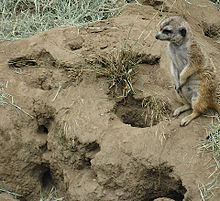
Meerkats in the midst of openings of passages to the burrows they have dug (here at the San Diego Zoo in California, USA).

Younglings
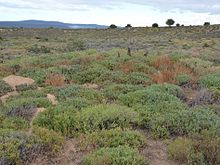
Habitat in the Karoo semi-desert, three meerkats keep watch
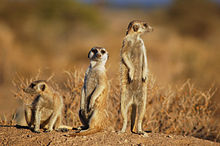
Meerkat in the western Kalahari near Keetmanshoop
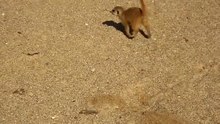
Play media file Meerkats in a zoo: playing, foraging (digging) and sifting (keeping watch)
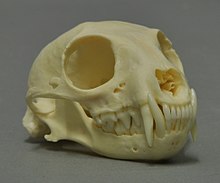
Skull (Collection Museum Wiesbaden)

Distribution area
Habitat
Meerkats live in southern Africa. Occurrences are known from the Republic of South Africa, western and southern Namibia, southwestern Botswana and a small part of southwestern Angola. They may also inhabit the lower altitudes of Lesotho. They live in dry, open landscapes with short grasslands and sparse woody growth. Their preferred habitat is savannah, but they also live in semi-deserts.
Search within the encyclopedia